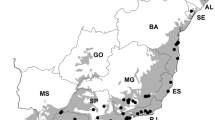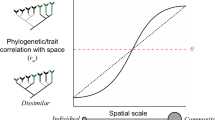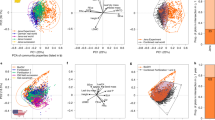Abstract
Three issues are discussed relevant to the controversy over using null models and observational data on guild structure to test community-level predictions based on limiting similarity theory. First, I argue that most limiting similarity theory is not based on reasonable assumptions for plants and that the theory that is relevant does not generate any predictions about expected guild proportionality on a small spatial scale. Therefore, regardless of adequacy of the statistical methods, the predictions being tested by the body of literature using null models to test for niche limitation are unlikely to be relevant in most plant comunities. Second, assuming that the predictions are after all worth being tested, I argue that most tests using the guild approach do not provide adequate explanations of how the defined guilds could lead to greater competition within vs. between guilds. If this is not true for the particular guilds used, the predictions of guild proportionality or size constancy will not be valid. Third, I address the controversy over whether field experiments can provide more solid evidence than observational data about the role of competition in determining community structure by (1) suggesting methods of dealing with potential drawbacks of field experiments, and (2) suggesting alternative experimental approaches for directly addressing issues about community structure.
Similar content being viewed by others
References
Ågren G.I. &Fagerström T. (1984): Limiting dissimilarity in plants: randomness prevents exclusion of species with similar competitive abilities.—Oikos 43:369–375.
Begon M., Harper J.L. &Townsend C.R. (1990): Ecology: individuals, populations, and communities —Blackwell Scientific Publ., Boston.
Chesson P.L. &Case T.J. (1986): Overview: nonequilibrium community theoreis, chance, variability, history and coexistence.— In:Diamond J. &Case T.J. [eds.]: Community ecology, Harper & Row, New York, pp. 229–239.
Connell J.H. &Slatyer R.O. (1977): Mechanisms of succession in natural communities and their role in community stability and orgnaisation.—Amer. Naturalist 111: 1119–1144.
Fageström T. (1988): Lotteries in communities of sessile organisms.—Trends Ecol. Evol. 3: 303–306.
Goldberg D.E. (1994): Influence of competition at the community level: an experimental version of the null models approach.—Ecology 75: 1503–1506.
Goldberg D.E. &Barton A.M. (1992): Patterns and consequences of interspecific competition in natural communities: A review of field experiments with plants.—Amer. Naturalist 139: 771–801.
Goldberg D.E., Turkington R. &Olsvig-Whittaker L. (1995): Quantifying the community-level consequences of competition.—Folia Geobot. Phytotax 30: 231–242.
Grime J.P. (1988): The C-S-R model of primary plant strategies— origins, implications, and tests.— In:Gottlieb L.D. &Jain S.K. [eds.]: Plant evolutionary biology, Chapman & Hall, London, pp. 371–393.
Hubbell S.P. &Foster R.B. (1986): Biology, chance, and history and the structure of tropical rain forest tree communities.— In:Diamond J. &Case T.J. [ed.]: Community ecology, Harper & Row, New York pp. 314–329.
Klimeš L., Jongepier J.W. &Jongepierová I. (1995): Variability in species richness and guild structure in two species-rich grasslands.—Folia Geobot. Phytotax. 30: 243–253.
Leigh R.A. &Johnston A.E. [eds.] (1994): Long-term experiments in agricultural and ecological sciences. —CAB International, Wallingford.
Lepš J. (1995): Variance deficit is not reliable evidence for niche limitation.—Folia Geobot. Phytotax. 30: 455–459.
MacArthur R.H. &Levins R. (1967): The limiting similarity, convergence, and divergence of coexisting species..—Amer. Naturalist 101: 377–385.
McLellan A.J., Fitter A.H. &Law R. (1995): On decaying roots, mycorrhizal colonization and the design of removal experiments.—J. Ecol. 83: 225–230.
Pacala S.W. &Silander J. (1990): Field tests of neighborhood population dynamic models of two annual weed species.—Ecol. Monogr. 60: 113–1134.
Pacala S.W. &Tilman D. (1994): Limiting similarity in mechanistic and spatial models of plant competition in heterogeneous environments.—Amer. Naturalist 143: 222–257.
Root R.B. (1967): The niche exploitation pattern of the blue-grey gnatcatcher.—Ecol. Monogr. 37: 317–350.
Shmida A. &Ellner S. (1984): Coexistence of plant species with similar niches.—Vegetatio 58: 9–55.
Silvertown J. &Law R. (1987): Do plants need niches? Some recent developments in plant community ecology.—Trends Ecol. Evol. 2: 24–26.
Simberloff D. &Dayan T. (1991): The guild concept and the structure of ecological communities.—Annual Rev. Ecol. Syst. 22: 115–143.
Smith A.P. (1973): Stratification of temperate and tropical forests.—Amer. Naturalist 107: 671–683.
Tilman D. (1982): Resource competition and community structure. Monographs in population biology.— Princeton University Press, Princeton.
Tilman D. (1988): Plant strategies and the dynamics and structure of plant communities—Princeton University Press, Princeton.
Tilman D. (1990a): Mechanisms of plant competition for nutrients: the elements of a predictive theory of competition.— InGrace J.B. &Tilman D. [ed.]: Perspectives in plant competition, Academic Press, San Diego, pp. 117–141.
Tilman D. (1990b): Constraints and tradeoffs: toward a predictive theory of competition and succession.— Oikos 58: 3–15.
Tilman D. (1994): Competition and biodiversity in spatially structured habitats.—Ecology 75: 2–16.
Tilman D. &Pacala S.W. (1993): The maintenance of species richness in plant communities.— In:Ricklefs R.E. &Schluter D. [eds.]: Species diversity in ecological communities, University of Chicago Press Chicago, pp. 13–25.
Wilson J.B. (1989): A null model of guild proportionality, applied to stratification of a New Zealand temperate rain forest.—Oecologia 80: 263–267.
Wilson J.B. &Roxburgh S.H. (1994): A demonstration of guild-based assembly rules for a plant community, and determination of intrinsic guilds.—Oikos 69: 267–276.
Wilson J.B. &Watkins A.J. (1994): Guilds and assembly rules in lawn communities.—J. Veg. Sci. 5: 591–600.
Wilson J.B., Gitay H. &Agnew A.D.Q. (1987): Does niche limitation exist?.—Funct. Ecol. 1: 391–397.
Wilson J.B. (1995): Testing for community structure: a Bayesian approach.—Folia Geobot. Phytotax. 30: 461–469.
Author information
Authors and Affiliations
Rights and permissions
About this article
Cite this article
Goldberg, D. Generating and testing predictions about community structure: Which theory is relevant and can it be tested with observational data?. Folia Geobot 30, 511–518 (1995). https://doi.org/10.1007/BF02803980
Issue Date:
DOI: https://doi.org/10.1007/BF02803980




